HBM Healthcare Investments (SIX:HBMN) has continued to produce solid NAV and share price performance, buoyed by recent IPOs from its private portfolio (with more expected to come) and a significant revaluation of largest holding Shanghai Cathay R&D. The Switzerland-listed fund holds a blend of private and listed healthcare companies and funds, diversified by geography and clinical focus, and has significantly outperformed the MSCI World Health Care Index over one, three, five and 10 years in both share price and NAV total return terms. Despite also outperforming its peer group average, and offering a c 4% dividend yield, HBMN currently trades on a wider discount to NAV than many of its peers.
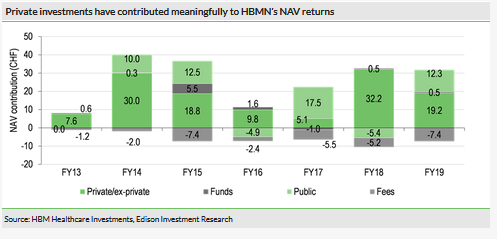
The Market Opportunity
A number of structural factors underpin the growth of the global healthcare sector in recent years. These include advances in the understanding of diseases, changing demographics (ageing populations require more medical services, while increasing affluence in emerging markets also drives healthcare demand) and a benign regulatory environment. In addition, many of the most innovative healthcare companies are unlisted, meaning they are out of reach of mainstream investors.
Why Consider Investing In HBMN?
Attractive Yield And A Discount Wider Than Peers
HBMN’s share price discount to NAV has narrowed substantially in recent years, and stood at 4.4% on 5 August compared with a five-year average of 20.3%. However, it remains at a wider discount than many of its peers. As a result of the fund’s high distribution policy, HBMN’s shares currently yield c 3.9%.


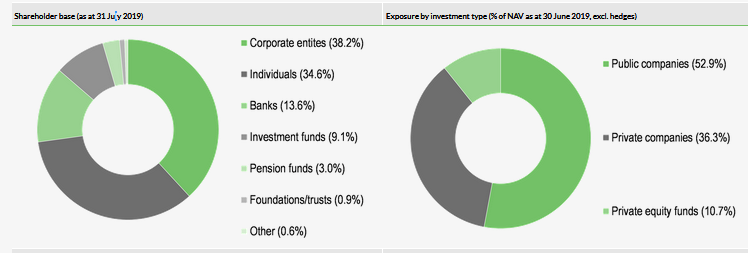
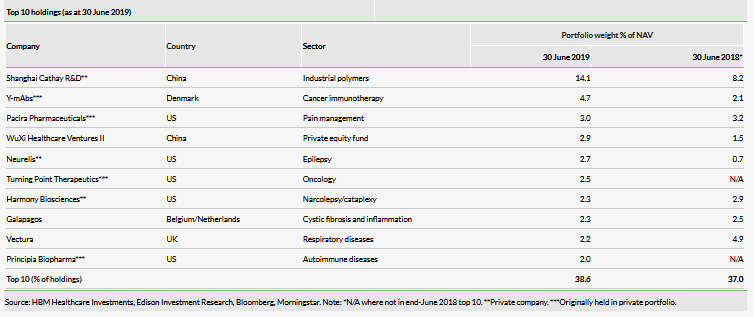
Market Outlook: Sector Fundamentals Remain Solid
As global equity markets have bounced back strongly from the sell-off in Q418, biotechnology has performed less well (Exhibit 2, left-hand chart), and the NASDAQ Biotechnology Index now lags the MSCI World Index total return over five years. This is a sharp contrast with the picture over 10 years, over which period the biotech index has outperformed the global index by c 140pp. The broader MSCI World Health Care Index has been less volatile, outperforming global equities by c 1pp over five years and c 60pp over 10 years (all in Swiss franc terms to end-July). The performance differential between biotech and healthcare arguably reflects broader investor sentiment. Because biotechnology is less well understood, and stocks in the sector are more vulnerable to binary outcomes based on clinical data than large, diversified healthcare stocks, biotech tends to be more heavily backed by generalist investors in times when risk appetite is high, and may see significant outflows when fear prevails over greed. The US election cycle can also weigh more heavily on biotech stocks. With the 2020 presidential race gathering momentum, the long-running debate over drug pricing has been reopened, and price tags on biotech-developed drugs – which may be life-changing, first-in-class treatments reflecting many years’ research and development work – often spark the severest criticism.
Short-term noise notwithstanding, fundamentals remain solid for biotechnology and healthcare, with ageing populations globally leading to higher demand for treatments, and greater affluence in developing markets increasing access to modern healthcare services. Greater understanding of disease processes is driving scientific advances, and the regulatory backdrop (particularly in the dominant US market) remains accommodative, especially for treatments that are truly innovative. In such an environment, and with forward P/E valuations for both biotech and healthcare stocks (as measured by Datastream indices) being below their five-year averages (compared with the broad US market forward P/E being above average), investors with a long-term view may benefit from considering an allocation to the sector.

Fund Profile: Healthcare Fund With Private Equity Roots
HBM Healthcare Investments (HBMN) is a Switzerland-listed healthcare investment company that began life in 2001 as HBM BioVentures. Originally set up as a private equity investor with a focus on the biopharmaceutical sector, it has evolved over the years into a diversified global portfolio of private and listed healthcare companies and private equity funds, and has been listed on the SIX Swiss Exchange since 2008. Although currently a little over half of the portfolio is invested in listed companies, many of these began as holdings in the private portfolio.
The fund aims to achieve long-term capital growth for its investors, but also has a high distribution policy, paying out c 3–5% of its NAV each year as a capital distribution. It measures its performance with reference to the MSCI World Health Care Index; however, investors should not expect performance to track the index, given the significant proportion of HBMN’s portfolio invested in private companies, and its complete lack of exposure to the ‘big pharma’ companies that dominate the index. The high weighting in private equity, where holdings are only valued periodically, means performance is likely to be less volatile than that of a pure equity fund. However, HBMN’s conservative valuation approach, with holdings only being revalued upwards in response to significant events, means that moves in the fortnightly NAV may occasionally be sharp.
HBMN has a six-strong non-executive board, and the fund management team is led by Chief Executive Officer Andreas Wicki and Chief Financial Officer Erwin Troxler.
The Fund Manager: HBM Partners
The Manager’s View: Exciting Opportunities Abound
Wicki says that targeted therapies are currently one of the most clinically significant areas of the healthcare market, with targeted cancer treatments at the forefront. Recent HBMN purchases in the targeted therapy space include SpringWorks Therapeutics (a private company) and Turning Point Therapeutics (bought pre-IPO but now in the listed portfolio). Describing the area as ‘a very promising story that will go on for a while’, Wicki says the recent acquisition of leading player Array BioPharma (not held by HBMN) by Pfizer (NYSE:PFE) for $48 a share (a 62% premium to the previous closing share price) underlines the potential for further corporate actions in the space. However, he is less positive on the emerging area of gene therapy, which has also seen significant buying of smaller players by larger firms, arguing that the ‘low-hanging fruit’ has already been acquired at high valuations. Wicki says it is hard to see who the future winners will be, given the technology is still in its infancy and ‘there are 250 companies out there at the moment burning money’. He adds: ‘We are cautious on this area; our focus is on mechanisms that have clear therapeutic benefits, such as Harmony Biosciences [treating narcolepsy by blocking histamine receptors] and Neurelis [developing a nasal spray to allow rapid treatment of epileptic seizures]. The majority of our portfolio companies are clearly making a difference through innovation.’
Looking ahead, Wicki says he does not see the pace of scientific discovery ebbing in the next few years, and that the increased willingness of ‘big pharma’ to look outside for innovation, through alliances, in-licensing or M&A, plays into HBMN’s hands as a backer of companies at the sharp end of clinical development.
Commenting on the number of recent private investments that have quickly come to market, the CEO says: ‘We have a seat at the table for these [pre-IPO financing] deals, as we are known to be a constructive investor.’ In the past 12 months, the portfolio has seen a number of successful IPOs (see Performance section), and has made new ‘pre-IPO’ investments in companies such as Jianke Pharmaceutical, SpringWorks and Viela Bio. However, the biggest potential IPO would be that of long-standing holding Shanghai Cathay R&D (‘Cathay’), formerly held through subsidiary Cathay Industrial Biotech, which Wicki says could be facilitated by the recent introduction of the Chinese STAR market, a science and technology board similar to Nasdaq in the US. Asia remains an important area of opportunity for HBMN, and with Cathay currently accounting for c 14% of the portfolio following a recent revaluation, Wicki says a partial exit after IPO and lock-up expiry could free up capital for redeploying elsewhere in Asia. This could be via existing private equity fund holdings, where the CEO says he hopes to see ‘exciting co-investment opportunities’.
Asset Allocation
Investment Process: Blend Of Private And Listed Healthcare
HBMN invests across the spectrum of healthcare and biotechnology, in both listed and unlisted companies, as well as private equity funds. It has two investment teams, one covering private equity and one covering listed markets, with the teams meeting weekly to discuss clinical and market developments. The majority of investment team members have a life sciences background.
The investment approach is bottom-up, with the teams employing fundamental analysis to construct a portfolio of 60–100 investments with solid long-term growth potential, from a universe of around 1,000 companies. The teams track trends in healthcare, attending conferences and keeping in close touch with a network of industry experts and executives, in order to generate investment ideas. Potential investments undergo qualitative and quantitative analysis, and the teams assess the companies’ intellectual property and stakeholder involvement before writing up a summary of the opportunity, which may include a recommendation to invest.
Although a little over half the portfolio is currently invested in listed companies, the private portfolio is arguably the driving force of the strategy. Including private equity funds, c 47% of the portfolio is currently invested in unlisted companies, and 25% of the listed portfolio by value (c 13% of the total portfolio), including the top three holdings, is invested in companies that HBMN has held since before their initial public offering (IPO). While many of the unlisted companies have been long-term holdings (notably largest position Shanghai Cathay R&D), some of HBMN’s more recent private investments have been made shortly before IPO, such as Turning Point Therapeutics, which was added to the portfolio in October 2018 and went public in April 2019.
The private equity team sources deals through its own networks, as well as via investment banks, other venture capital investors and directly, with the aim of making typically around eight to 12 deals a year. HBMN seeks to be an active lead or co-lead investor, with board representation, and to share entrepreneurial responsibility along with the management team. All private investments are made with a clear expectation of an exit, which may be via an IPO or trade sale.
HBMN takes a conservative approach to valuing its investments. Listed company stakes are valued at market prices, and will thus reflect positive or negative developments as they occur. In the private portfolio, most positions are valued at acquisition cost. Valuations will be adjusted (up or down) when a new financing round with a third-party lead investor effectively establishes a new ‘price’, and positions will be written down in steps of 25%, 50%, 75% or 100% in response to negative clinical or regulatory developments as they occur. However, positive developments are only reflected in valuations at the point of a liquidity event, such as an IPO, trade sale or third-party financing round. The exception is where an unlisted company has significant revenues and profits, in which case it will be valued based on appropriate price/sales and price/earnings multiples.
The portfolio is diversified by clinical focus, development stage and geography. Direct investments are biased towards developed markets, while the private equity funds portfolio has a significant tilt to emerging markets such as China and India, where it may be harder for the investment team to make an assessment of individual private companies. Investments are made for the long term, with the aim of achieving capital growth. Positions are continually reviewed, and risk management activity also includes ongoing monitoring of global markets and macroeconomic developments. As a further risk reduction measure, HBMN has a short position in an ETF tracking the Nasdaq Biotechnology Index, to provide downside protection to the listed portfolio in volatile equity market conditions. The short position has been reduced as the portfolio weighting in listed companies has fallen (down from around two-thirds at 30 September 2018) and at 30 June 2019, c 9% of the public portfolio was hedged, compared with c 20% nine months earlier.
Current Portfolio Positioning
At 30 June 2019, HBMN’s portfolio was made up of 45 listed companies, 32 private companies and 14 private equity funds, as well as some smaller undisclosed investments in each category. The top 10 holdings made up 38.6% of the total, a slight increase in concentration compared with 37.0% a year earlier. The largest position by some margin is in Shanghai Cathay R&D (formerly held as Cathay Industrial Biotech, or CIB), a private Chinese manufacturing company using biotechnology to produce a range of goods including biopolymer textiles (‘green nylon’). The position was revalued upwards significantly in the first half of 2019 (to CHF192m versus CHF90m at 31 December 2018), based on a financing round and transaction values. HBMN has also exchanged its US dollar-denominated holding in Cayman Islands subsidiary CIB for a renminbi-denominated holding in the parent company, which has diversified the fund’s currency profile (see Exhibit 4, right-hand chart).
As shown in Exhibit 3, HBMN is broadly diversified by clinical focus. It has recently added a new category of ‘digital health’, bringing together names such as privately held online pharmacy/ healthcare websites 1mg (India) and Jianke Pharmaceutical (China), and connectRN, a US-based app for sourcing temporary nursing staff, which Wicki describes as ‘Uber (NYSE:UBER) for nurses’. He adds: ‘We are careful in the digital health segment to go for disruptors with an advantage in an analogue world,’ explaining how connectRN has the potential to revolutionise the current inefficient process for finding agency nurses to provide immediate cover.

Exhibit 4 shows HBMN’s portfolio exposures by stage and currency, again illustrating its diversification. Although many of its new investments are in small companies that may be at a relatively early stage of development, almost 40% of the portfolio is invested in companies with products on the market, half of which are already profitable.
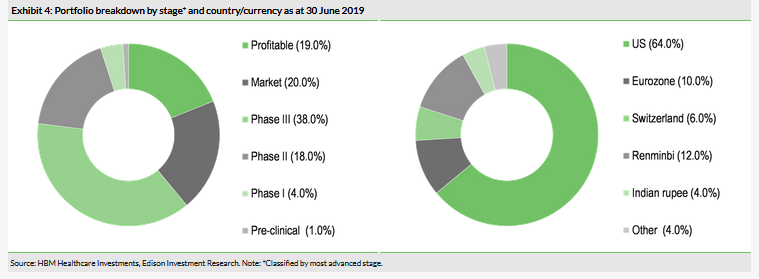
Recent investments in the private space include SpringWorks Therapeutics (March 2019), a specialist in severe rare diseases and cancer, Viela Bio (June 2019, immunology/inflammatory diseases), and Arrakis Therapeutics (June 2019), a platform company targeting disease treatment through RNA modification. The SpringWorks investment was the last of 15 new private investments made in FY19, a markedly higher rate of activity than the usual circa eight to 12 investments per year. Wicki says both SpringWorks and Viela are viewed as pre-IPO investments, building on the recent pattern of HBMN’s new private holdings shortly coming to market, such as YmAbs Therapeutics (initial investment in October 2017; IPO in September 2018), Principia Biopharma (bought in August 2018 and listed in September 2018) and Turning Point Therapeutics (first investment in October 2018; IPO in April 2019). All three of these IPOs have made significant positive contributions to HBMN’s performance.
Performance: Strong Returns Driven By Private Portfolio

Despite considerable volatility in listed biotechnology and healthcare markets over recent years, HBMN has produced consistently positive NAV total returns over periods to 31 July 2019 (Exhibit 6). Its lower volatility can be attributed largely to its exposure to private companies, which it values conservatively (see Investment process). Recent IPO activity has undoubtedly boosted recent returns, which feeds into longer-term performance, but even so, annualised NAV returns of more than 15% over one, three, five and 10 years compare very favourably with the Swiss franc performance of the MSCI World Health Care Index (see Exhibits 7 and 8). Share price returns have been higher for most periods shown, with the discount to NAV having narrowed substantially over the past two years.


Specific contributors to recent performance have mainly originated in the private portfolio, and include the upward revaluation of the stake in Shanghai Cathay R&D. IPOs have contributed strongly, including the market debut in April 2019 of Turning Point Therapeutics (up 60% on its first day of trading and a further 39% since then), as well as the earlier IPOs of Y-mAbs Therapeutics and Principia Biopharma (both in September 2018). Revaluations based on funding rounds made a notable positive contribution, for example at Neurelis (while relatively flat over six months, the value of the stake in the epilepsy specialist has doubled compared with 12 months ago), as well as at two Indian holdings, Sai Life Sciences (where a US private equity investor acquired a significant stake in Q1 2018/19, leading to a more than 200% increase in the value of HBMN’s holding) and 1mg, where HBMN contributed CHF5m in a CHF70m funding round in December 2018, resulting in a CHF8m increase in the value of the existing holding.
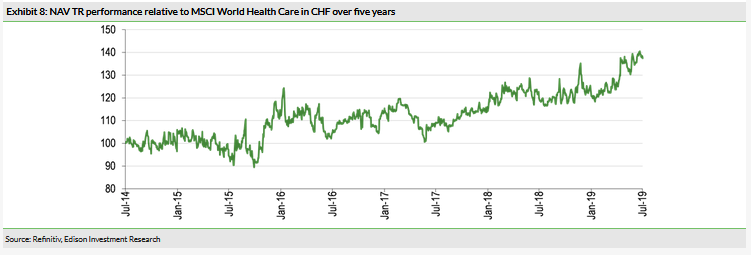
Discount: Wider Than Peer Average Despite Re-rating

At 5 August 2019, HBMN’s shares traded at a 4.4% discount NAV. This was narrower than the 7.7% average over the previous 12 months, following a c 5% jump in the share price towards the end of July. The discount had widened after briefly reaching a premium of c 1% in late September 2018, although in recent years it has narrowed substantially, and the current level compares with averages of 15.9%, 20.3% and 23.5% over three, five and 10 years, respectively. Despite its very strong recent performance, boosted by a series of IPOs from the private portfolio that underline the success of HBMN’s investment approach, the fund continues to trade at a discount wider than the peer group average (see Exhibit 10). It is notable that fellow Switzerland-listed peer BB Biotech (which also traded at a persistent discount until relatively recently) is currently trading on a double-digit premium. Syncona and International Biotechnology Trust, which each have private equity exposure, are also both currently trading at a premium to NAV, suggesting there is continued scope for HBMN’s discount to narrow.
Capital Structure And Fees
HBMN is structured as a closed-ended investment company, listed on the SIX Swiss Exchange. It has one class of share, with 7.0m ordinary shares in issue. A new share buyback programme was launched in June 2019 (following the completion of the 2016 programme), under which up to 696,000 shares (10% of shares in issue) may be bought back in the three years ending 27 June 2022. No shares have yet been bought back under this programme. Gearing is available through two bond tranches of CHF50m each, one maturing in 2021 with a coupon of 2.0%, and one maturing in 2023 with a coupon of 2.5%. This equates to gross gearing of 7.0%. At 30 June 2019, net gearing was c 0.6% after accounting for cash and cash equivalents, minus the liability from the market hedge.
HBM Partners receives an annual management fee of 0.75% of HBMN’s NAV plus 0.75% of its market capitalisation, calculated and paid quarterly. For FY19 we calculate ongoing charges at c 1.41% (FY18: 1.25%). A performance fee (15% of outperformance) may also be earned if HBMN’s year-end NAV per share (before accounting for any performance fee) is more than 5% above the high-water mark (the year-end NAV at which a performance fee was last paid). At end-FY19, the CHF194.36 (pre-performance fee) NAV per share was 20.0% higher than CHF161.87 at end-FY18, which was the previous high-water mark. Therefore CHF194.36 becomes the new high-water mark, and a performance fee of CHF31.9m (FY18: CHF15.9m) is payable for the year.
Dividend Policy And Record
Since 2013, HBMN has followed a high distribution policy, in recognition of the desirability to shareholders of investment income in an era of historically low interest rates. Under the policy,
c 3–5% of NAV is returned to investors each year through cash distributions, which may be supplemented by share buybacks up to a combined total of c 8% of NAV. Before FY18, the cash distribution was paid out of capital reserves, usually in June or July. In respect of FY18, the CHF7.00 distribution was split, with CHF5.50 coming from capital reserves (paid in June) and CHF1.50 as a nominal value repayment (paid in September). For FY19, the whole CHF7.50 distribution (a 7.1% increase on the prior year) will be in the form of a withholding tax-exempt par value repayment in September. This is a more tax-efficient way for HBMN to fund the distribution than transferring part of the nominal value into reserves. Total distributions have grown at a compound annual rate of 16.5% over the past five financial years, and the FY19 distribution of CHF7.50 represents a yield of 3.9% on the current share price.
Peer Group Comparison
In Exhibit 10 we present HBMN alongside the members of the Association of Investment Companies’ Biotechnology & Healthcare sector, fellow Switzerland-based fund BB Biotech, and Woodford Patient Capital Trust (WPCT), which is classed as a UK All Companies fund but has c 50% of its portfolio invested in healthcare companies, many of them unlisted and/or at a relatively early stage of development. None of the funds is a direct comparator to HBMN, as the majority invest only or mostly in listed companies (either specifically in the area of biotechnology or more broadly across the healthcare sector), or, in the case of Syncona, mostly in unlisted companies.
In Swiss franc terms, HBMN’s performance over 12 months ranks comfortably at the top of the nine-strong peer group, 10.3pp ahead of the next-best performing fund and 17.0pp above the average. This has been partly driven by a number of successful IPOs from HBMN’s private portfolio, as well as the significant revaluation of the stake in Shanghai Cathay R&D. Over three, five and 10 years, HBMN ranks second of eight, first of seven, and second of five, respectively. In spite of this strong performance record, HBMN’s discount to NAV is wider than the majority of the peer group. (While broadly in line with the average including the troubled WPCT, HBMN’s discount is significantly wider than the 0.5% peer group average excluding WPCT.) Ongoing charges are towards the high end for the group, reflecting the greater complexity of managing a portfolio that includes a significant portion of unlisted companies, and in common with more than half the peers, HBMN may earn a performance fee. (Note, however, that all performance figures are net of fees.) The fund is currently 0.6% geared versus average gearing for the peer group of 6%.
Although biotechnology and healthcare (particularly early-stage companies) is not a high-yielding area of the market, some funds choose to reward investors with a partial return of capital, to smooth out total returns. HBMN is one of four funds in the peer group to follow such a strategy, and its 3.9% dividend yield is the third-highest in the peer group. (Polar Capital Global Healthcare and Worldwide Healthcare Trust pay a ‘natural’ yield, while Syncona has recently reviewed its dividend policy and does not intend to pay dividends in the future.)
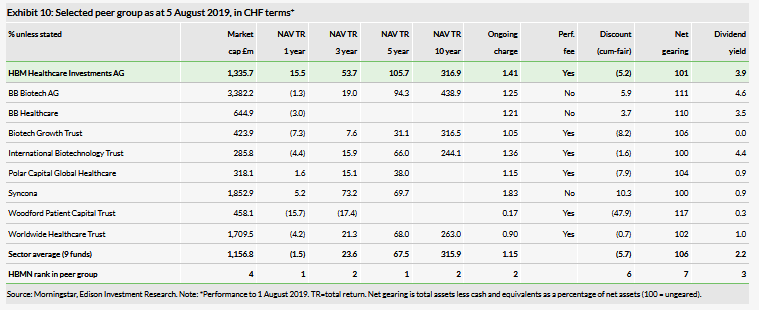
The board
There are six directors on HBMN’s non-executive board, all independent of the manager. The chairman, Hans Peter Hasler, was appointed to the board in 2009, while the vice-chairman, Professor Heinz Riesenhuber, has served as a director since the fund’s launch in 2001. The other directors and their years of appointment are Dr Rudolf Lanz (2003), Robert A Ingram (2006), Dr Eduard E Holdener (2008) and Mario G Giuliani (2012). The majority of the directors have professional backgrounds as pharmaceutical and biotechnology company executives, while Professor Riesenhuber is a retired German MP and Dr Lanz is a lawyer and corporate financier. The directors have specific areas of responsibility regarding the monitoring of HBMN’s portfolio and the wider market backdrop. Messrs Hasler and Ingram cover sector and marketing strategies and regulatory (FDA) approval; Dr Holdener monitors research and development; Professor Riesenhuber and Mr Giuliani assess management, production and audit; Dr Lanz also covers audit, as well as finance and M&A transactions.